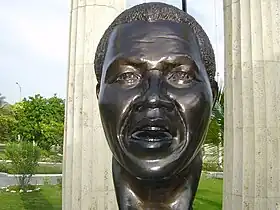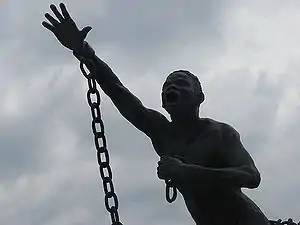Benkos Biohó
Benkos Biohó (late 16th century — 1621), also known as Domingo Biohó was a Mandinka and South American leader who escaped from the slave port of Cartagena with ten others and founded San Basilio de Palenque, then known as the "village of the maroons", located in what is now Northern Colombia. In 1713 it became the first free village in the Americas by decree from the King of Spain, when he gave up sending his troops on futile missions to attack their fortified mountain hideaway.[1][2]
Benkos Biohó | |
|---|---|
 Statue of Benkos Biohó | |
| Born | |
| Died | 16 March 1621 |
| Other names | King of Arcabuco |

Biography
Biohó was born into a royal family in Guinea Bissau. He was of Mandinka origin[3] He was seized by the Portuguese slave trader, Pedro Gomes Reinel, sold to businessman Juan Palacios, and later, after transportation to what is now Colombia in South America, sold again to the Spaniard Alonso del Campo in 1596, in Cartagena de Indias. He made his first escape when the boat that was transporting him down the Magdalena River sank. He was recaptured but escaped again in 1599 into the marshy lands southeast of Cartagena. He organized an army that came to dominate all of the Montes de María region. He also formed an intelligence network and used the information collected to help organize more escapes and to guide the runaway slaves into the liberated territory, known as settlement. He used the title "king of Arcabuco".
On 18 July 1605, the Governor of Cartagena, Gerónimo de Suazo y Casasola, unable to defeat the Maroons, offered a peace treaty to Biohó, recognising the autonomy of the Matuna Bioho Palenque and accepting his entrance into the city armed and dressed in Spanish fashion, while the palenque promised to stop receiving more runaway slaves, cease their aid in escape attempts, and stop addressing Biohó as "king". Peace was finalized in 1612 under the governorship of Diego Fernández de Velasco. The treaty was violated by the Spaniards in 1619 when they captured Biohó as he was walking carelessly into the city. He was hanged and quartered on 16 March 1621. Governor García Girón, who ordered the execution, argued bitterly that "it was dangerous the extent to which Biohó was respected in the population" and that "his lies and enchantment would drive the nations of Guinea away from the city."[4]
The betrayal contributed to the history of distrust of Colombia's government.[5]
By the end of the seventeenth century, Montes de María had over 600 maroons, under the command of Domingo Padilla, who claimed for himself the title of captain while his wife Jane adopted that of viceroy, and successfully challenged further attempts at sovereignty from the colonial authorities.
San Basilio de Palenque was declared Masterpieces of the Oral and Intangible Heritage of Humanity by UNESCO in 2005.[6] At about 80 kilometres (50 mi) east of Cartagena, hills of strategic value, used as lookout posts, still bear the names of the runaway neighborhood: Sincerin, Mahates, Gambote.
References
- Tomaselli, Wesley (November 20, 2017). "The Colonial Betrayal that Haunts Colombian Peace". Ozy. Retrieved November 20, 2017.
- "How this runaway slave founded San Basilio de Palenque, first free town in the Americas". Face2Face Africa. 2018-05-18. Retrieved 2020-08-31.
- "Benkos Bioho's Life Mattered! And Here's the Proof!". The African American Heritage Museum & Cultural Center. 2021-03-03. Retrieved 2022-09-29.
- Aquiles Escalante, Palenques in Colombia, in "Maroon Societies: Rebel Slave Communities in the Americas", ed. by Richard Price (Baltimore: Johns Hopkins University Press, 1996), pp. 77-9.
- Tomaselli, Wesley (November 20, 2017). "The Colonial Betrayal that Haunts Colombian Peace". Ozy. Retrieved November 20, 2017.
- Cultural Space of Palenque de San Basilio (in Palenquero), Ministry of Culture of the Republic of Colombia, retrieved 2018-06-12
{{citation}}: CS1 maint: unrecognized language (link)
Further reading
- Djemâa Chraïti Benkos Biohò L'esclave libre ou le roi de la Matuna chraitihttps://editions-sydney-laurent.fr/brand/djemaa-/Prada Fortul, Antonio (2001), Benkos Biohó: las alas de un cimarrón, Barranquilla: Antillas, ISBN 9789588152189
External links
- Africans in Americas
- Central Africans and Cultural Transformations in the American Diaspora By Linda Marinda Heywood ISBN 0-521-00278-8
- Africa and the Americas: Interconnections During the Slave Trade By José C. Curto, Renée Soulodre-LaFrance Published 2005 Africa World Press Slave trade ISBN 1-59221-272-7
- Africana: The Encyclopedia of the African and African American Experience By Henry Louis Gates, Anthony Appiah ISBN 0-465-00071-1